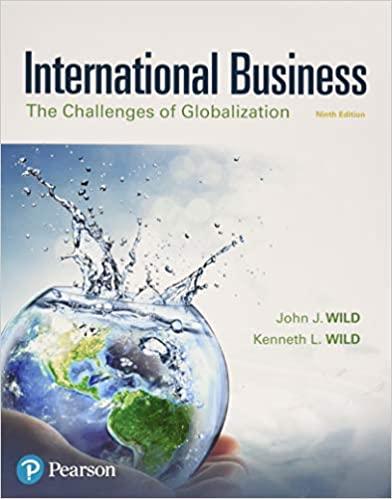Question
Resources Read/review the following resources for this activity: Case: Flex Industries Limited Lecture Minimum of 1 Internet source Introduction The case study highlights the problems

Resources
Read/review the following resources for this activity:
- Case: Flex Industries Limited
- Lecture
- Minimum of 1 Internet source
Introduction
The case study highlights the problems of corporate governance in emerging market economies, clarifies the responsibilities of diverse stakeholders and evaluates issues confronting firms in these economies.
Activity Instructions
Respond to the following:
- What is the controversy surrounding Flex Industries? Discuss the chain of events.
- What are the roles and responsibilities of different stakeholders? Analyze their behavior with respect to the Flex incident.
- What has been the role of the market during and after the controversy? What is the theory behind the market reaction?
- Who has more disciplining power in corporate governance the market, the media or the government?
- From the case discussions what according to you is the key corporate governance concern in emerging markets?
When analyzing a case study, all the used references (including the Internet) should appear within the text [e.g. (John Doe, 2008)] and on the references page. You are expected to apply all applicable course concepts, as well as those specific to the chapter from which the case or paper topic is drawn. The analysis should also contain a summary of related current developments obtained through searches on the Internet.
Writing Requirements (APA format)
- References page (minimum of 1 Internet source)
Lecture
Introduction
Chapter 5 analyzes problems of information and control in financial markets. It first discusses asymmetric information issues that are especially relevant to EFMs - a) they rely heavily on debt as opposed to equity because of underdeveloped equity markets; b) the debt is more in the form of bank loans as opposed to securities like bonds, for example, because of underdeveloped bond markets; c) there is more short term debt rather than long term debt; and d) the preference is for secured versus unsecured loans. Investors in developed financial markets have access to substantial amounts of information (e.g. data on companies) from institutions of information that they can use to make informed decisions. On the contrary, EFMs lack accurate information, so the question is how do EFMs behave in the absence of information? How does the problem of adverse selection play out in EFMs? Who monitors corporate performance and who oversees the monitors? Is there a mechanism in place to control self-dealing by insiders and, if so, how effective is it?
In the US, there is a conflict of interest between the management and the stockholders and the problem is one of the principal (stockholder) effectively monitoring the agent (manager) or what is commonly referred to as the principal-agent problem. On the other hand, in most EFMs the control conflict is not between the stockholders and the management but between a) the controlling stockholders ('insiders' who are usually members of the family) versus the outside stockholders ('outsiders') and b) debtors (primarily banks) and controlling stockholders - banks need to protect themselves against expropriation of the firm's assets by the latter (thus leading to a debt default) when the firm is privatized, for example. It then goes on to discuss issues of corporate governance in EFMs and the role that institutions of information like accounting firms, credit rating agencies, disclosure laws etc. perform in efficient capital markets.

Step by Step Solution
There are 3 Steps involved in it
Step: 1

Get Instant Access to Expert-Tailored Solutions
See step-by-step solutions with expert insights and AI powered tools for academic success
Step: 2

Step: 3

Ace Your Homework with AI
Get the answers you need in no time with our AI-driven, step-by-step assistance
Get Started


